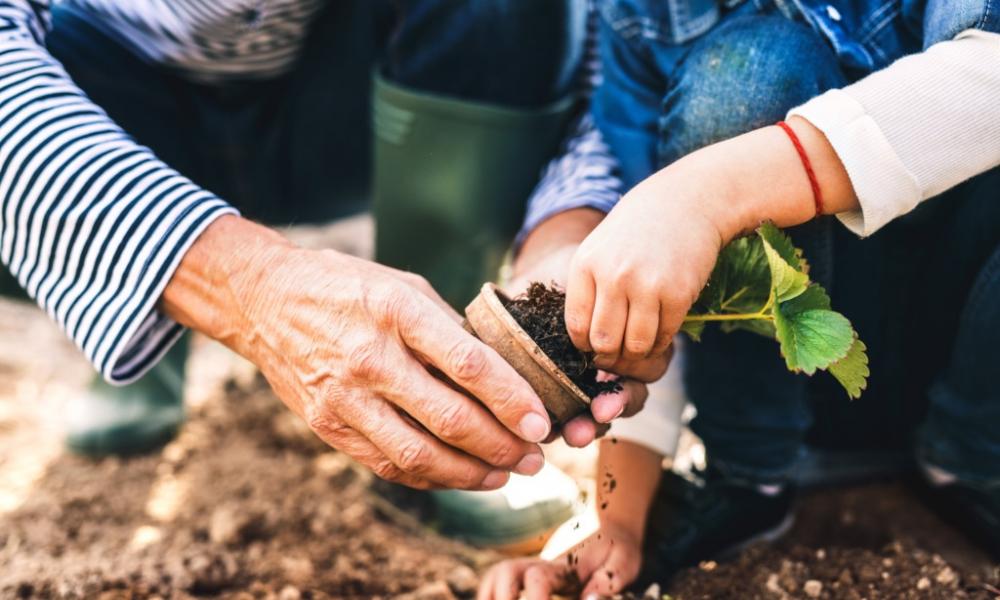
Protecting your joints when you're gardening
Gardening is a really good form of exercise but doing some actions over and over can lead to swelling and pain if you have psoriatic arthritis (PsA), and you may need to take short breaks and pace yourself to avoid flare-ups. Aim for a balance between exercising your joints and muscles to stay mobile without straining them. ‘Little and often’ is usually the best way, and switching between different jobs will also help. The following tips should help to protect your joints:
Change task to reduce repeated strain on the same joints
Don’t feel you have to carry on until you finish the job. Try switching from one task to another after 20 minutes so that you rest some joints and exercise different ones for a while. For example, break up harder jobs like hoeing weeds with spells of something gentler like pricking out seedlings.
Take a break between job if you need to and use a timer to help you pace yourself if you think it’d be useful.
If a task causes difficulty or discomfort, it may help to speak to an occupational therapist. They’ll help you to understand why the task is causing pain and suggest changes to the way you do tasks or tools that will reduce the strain.
Spread the load
When carrying items, try to spread the load by lifting with your hands and arms, rather than just your fingers. Try resting a tray of seedlings on your forearms, for example. Keep your elbows tucked in to reduce the strain on your shoulders and elbows.

Use a garden stool
Using a stool is less tiring than standing/kneeling and reduces the load on your weight-bearing joints. You'll be closer to the ground so you can use shorter, lighter tools. You won't be able to reach as far, though, so you’ll need to plan your borders around this or buy long-reach or extendable handled tools.
Make sure you can get up easily from the stool – avoid sitting too long and getting stiff as this will make rising more difficult.
Get a good grip
Slip a spongy rubber sleeve over the handle of a hoe or rake to increase your grip. This will reduce the strain on your knuckles and jarring of the joints. A good pair of gloves will also help you to grip more easily.

Wear splints
An occupational therapist will be able to tell you if splints might help to support the joints of your hand and wrist and reduce the strain of some gardening tasks.
A wrist splint may helpful if you have painful or weak wrists, while a thumb splint may be useful for tasks that need you to have a tight grip for a long time (for example pruning).
Wearing gardening gloves over splints will keep them clean and also increase your grip.
Plan ahead to avoid unnecessary effort
If you find walking difficult, avoid too many journeys up and down the garden by taking all the things you need in a wheelbarrow, bucket or trug. This will cause less strain on your hands, wrists, elbows and shoulders.
You may need to get help with some of the heavier jobs, especially if you’re making changes to the layout of your garden. Decide beforehand what you need help with and what you prefer to do yourself. Make sure your helper understands that the aim is to allow you to manage your garden yourself and doesn’t take on more than you really want them to.
Avoid heavy lifting
If you can’t get help lifting bags of compost, especially from the boot of a car, think about buying two small bags instead of one large one. Many manufacturers now include handles on their compost bags, which makes them much easier to carry.
Use the correct tools for the job
Use lightweight or long-handled tools, and carry items in a wheelbarrow. Look after gardening cutters and keep them sharp so they're easier to use.
Planning your garden
Choosing plants
Choosing low-maintenance plants will make things easier if you go on holiday or into hospital, or if don’t feel up to gardening for a while. Plants like elephant’s ears, cranesbill, lavender and periwinkle backed by shrubs such as barberry, escallonia, senecio and viburnum can take care of themselves for long periods once their roots are deep in the soil.
Create a wildlife area using wildflower seeds or native plants, which don’t usually need tending. This is also good for bringing wildlife into your garden.
There are a number of books and websites on low-maintenance gardening which will suggest plants that don’t need a great deal of attention.
Paths and beds
It's a good idea to have firm paths alongside beds and borders, especially if you find it difficult to keep your balance on uneven ground, so you can tend to most of the area without having to step onto the soil. Non-slip paving slabs make safe paths and they can be used for shallow steps where the ground level changes. Wooden handrails alongside steps are also helpful.
The beds should be quite narrow so you can reach the middle and back without stretching.
If you find it difficult to bend to ground level or need to work from a wheelchair, a raised bed would be helpful. If you have a sloping garden, you can make a terrace by building a low wall and filling behind with soil, which has the effect of making a raised bed. Even raising the soil level a small amount will make the bed easier to manage.
If you need a wheelbarrow, choosing one with two wheels and a bar-type handle can be helpful. The weight of the contents rests mainly on the axle rather than on your arms. This type of barrow is more stable and easier to empty without bending down or twisting.
Preparing the soil
Digging the soil
Improving the quality of your soil will make cultivation easier. Heavy clay can be made lighter by digging in manure or compost. Adding sharp sand or grit lets air into the soil, making it easier for roots to bed in. It also makes it easier to dig in the future. Turning the soil over in autumn exposes it to winter frosts and makes it easier to break down, ready for sowing the following season.
When you do need to dig, bear in mind the following:
- A border spade is lighter and easier to handle than a digging spade. The blade is smaller so you won’t be tempted to dig large spadefuls.
- Soil tends to cling to ordinary carbon steel spades, which adds weight, so stainless steel is a better choice. It’s also easier to clean afterwards.
- Spades with extra-long handles make it easier to move the soil and reduce the need to bend.
- If your soil is light and crumbly, use a border fork instead of a spade – it’s lighter and moves through the soil more easily.
- Clamping an extra handle part-way down the shaft of your spade or fork saves bending too far and provides a comfortable grip for your lower hand without twisting your wrist.

If the soil is light and sandy, you may not need to dig at all. A soil miller is a tool with star-shaped wheels that break down the soil into fine particles as you move it backwards and forwards.
Well-rotted manure spread over the surface can be incorporated into the soil with the soil miller. This is a good tool for use with a deep-bed system.

Weeding
You can reduce the number of weeds you have to deal with by covering the soil with a 5 cm (2 inch) layer of shredded bark or mulch. This stops the soil getting any light and makes it more difficult for weeds to grow. Alternatively, you can cover the bed with black polythene, cut slits into the sheet and plant seeds through the holes. Scatter a layer of gravel over the top to hold down the polythene and improve the border’s appearance.
Annual weeds should be hoed while they’re young and easy to deal with. We don’t recommend a draw hoe or a Dutch hoe because the blade has to be lifted and lowered over and over, which can strain your joints. A push-pull hoe skims the soil surface back and forth, chopping off the weeds at ground level with little effort. You can fit an extra-long handle to the hoe if you need to.
Weeding by hand is tiring if you can’t easily reach down to ground level. You can try a weed puller instead. A weed puller has a steel blade that you push into the ground alongside the weed. Closing the handle grips the weed and pulls it out. Although this only deals with one weed at a time, it saves raking together and picking the weeds up afterwards. It’s also easy to use sitting down.
If you don't want to use a weed puller, you can collect small amounts of weeds and leaves in a bucket or bag. You can buy tools to help you pick up garden rubbish without bending.
The lawn
Lawns need mowing regularly throughout the summer, so if you’re often away from home and don’t have help it may be worth replacing the lawn with a low-maintenance area such as paving or gravel. You can leave spaces for growing suitable plants, or you could grow plants in pots on the paved/gravelled area.
Island beds in lawns make mowing more complicated. It’s easier to move the mower around if the lawn is a simple shape with straight edges. Make sure the mower is stored somewhere that you can get to easily. If you’re buying a new mower, try to choose a lightweight model with a large-grip handlebar and easy-to-push buttons.
Mowing and clipping the lawn
Most lawnmowers have power-driven blades and many electric models are fairly light to push. Cordless battery-operated mowers are now available. These can be easier to move around, although some models do have heavy batteries.
We don’t recommend petrol-engined mowers because they’re usually very heavy to move and manage. If you prefer a manual mower, look for one with a single horizontal handlebar rather than two separate handles – you can then do some of the pushing with your stomach to reduce strain on your arms and wrists.
Lightweight edging shears with generously padded long handles will give a more comfortable grip and reduce jarring of the joints. Or you could use a nylon cord trimmer that operates vertically – you simply walk along holding it against the edge of the lawn.
You may eligible for getting support with tending the lawns, via the National Disability Insurance Scheme. If this applies to you consider asking about this.
Growing plants
Sowing seeds
If you have trouble bending down to ground level, you can buy tools to help with sowing seeds. The loaded tool is pushed along the drill, emptying seed as it goes along. You can also buy or make your own ‘seed tapes’, which are strips of soft paper with seeds attached at even spaces. You can lay these into a shallow trench and cover them over.
To sow peas or beans, you can sow drop them into the trench down a length of plastic pipe. Use a lightweight mini-rake to draw a shallow layer of soil over the trench to cover the seeds.
Planting out
Planting out summer bedding plants involves a lot of bending. You can avoid this by only growing shrubs and herbaceous perennials. Alternatively, you can dig a hole using a long-handled trowel, put the plant on the blade and lower it into the soil. You can do this sitting down if it’s easier. Pot-grown plants are the most suitable for this method.

Using containers
You can use containers to make sure you can work at a height that’s suitable for you. You can grow annual bedding plants, heathers, herbs, spring bulbs and even dwarfing vegetables and fruit trees in this way.
Heavy tubs can be put on wheels in case you need to move them around. Wheeled containers with a braking system are also available – these may be easier to manage, but they’re more expensive.
Watering the plants
It’s useful to have a mains water supply at a central point of the garden so that you can water any part using a short hose or sprinkler. If this isn’t possible, attach a short hose to on outside tap if you have one, or place water butts where you need them most. You can fill them from time to time with a hose if you need to, and dip a small watering can into the tanks when you need to water the plants. Use both hands to spread the weight when you use a watering can.
If you have free-draining borders that are in full sun, it’s best to use them for growing drought-resistant plants such as wallflowers, rosemary, broom and cotton lavender, which come to no harm if they dry out for a few days. This will help reduce the amount of watering you need to do.
Mulching with shredded bark reduces water loss, but the mulch should only be put in damp soil. Hanging-baskets keep their moisture longer in light shade, and plants like fuchsias, ivy-leafed geraniums, lobelias and Busy Lizzies grow well in these conditions.
A hanging-basket sprayer is useful for watering a basket that’s too high to reach with a watering can. You can buy special hanging-basket compost with crystals that help keep moisture in so you don’t have to water so often. Crystals are also available for mixing in with standard compost.
Growing fruit and vegetables
Growing fruit
You can buy fruit trees that have been grafted onto dwarfing rootstocks. This stops them growing too tall so you can reach the fruit more easily. You can grow fruit trees as cordons in a slanting row, or espaliers and fans, perhaps against a wall or fence. Prune them to a height that suits you.
Gooseberry plants can be grown on a leg – a single clear stem 60–90 cm (2–3 feet) high. This saves you bending down to pick them. Strawberries are easier to gather if they’re grown through holes in a barrel or in hanging baskets.
Growing vegetables
If you want to grow tomatoes and cucumbers outside but your soil isn’t good enough, you can use growbags. Growbags that have been used for growing tomatoes and cucumbers in the greenhouse can be used the following year for salad crops such as lettuce, radishes, spring onions and beetroot.
Place growbags on a bench if it’s easier to reach them. Many fruit and vegetables can also be grown in hanging baskets which can make them easier to tend and harvest.
Try the deep-bed method for an easier way of growing vegetables.
The deep-bed method
The deep-bed method a labour-saving way of growing vegetables. You may need help to dig the plot to start with, but then you won’t need to do any more digging for several years.
Divide the plot into strips 1.2 m (4 feet) wide, separated by paved paths. Dig the ground over well, adding manure, peat or well-made garden compost into each trench. Don’t walk over the soil after this stage. You can do all cultivation, planting, weeding, feeding and harvesting from the paths using long-handled tools. Because the soil isn’t compacted, you can sow more root crops than normal – the growing plants push each other sideways in the easily crumbled soil. You don’t need to sow in rows, and planting many seeds will make it harder for weeds to grow.
You’ll need to lay more manure on the surface during the following autumn. Worms and the winter weather will work the manure down into the soil, and light cultivation in the spring will make sure it’s fully mixed in.
Garden buildings and furniture
If you need a greenhouse, potting shed, tool shed and cold frame, try to place them near each other. Clustering buildings saves carrying pots, compost and seed trays unnecessarily.
The lids of some glazed cold frames are very heavy to lift. A raised frame with a hinged lid covered with lightweight corrugated plastic sheeting and connected to a pulley and counterbalance weight is much safer and easier to manage.
The greenhouse
Make sure the staging in your greenhouse is at the right height – you should be able to work comfortably while sitting on a chair. You may prefer to rest your elbows and forearms on the staging while you work. If all the staging is the same height, you can slide trays along instead of lifting them.
Thermostatically controlled fan heaters, automatic vent openers and capillary watering systems can help to to provide the right growing conditions with little effort from you. You can even avoid digging the border soil by using growbags for tomatoes and cucumbers.
If you use a wheelchair, choose your greenhouse carefully. Make sure the doorways are wide enough and the thresholds low enough to fit your wheelchair through.
Garden seating
Garden seating shouldn’t be too low and should have a supportive backrest. Having seating in your garden will encourage you to pace yourself and take frequent breaks, especially if it’s placed in the areas you work in most.
Hedges and fences
Herbaceous borders
Traditional herbaceous borders need a lot of attention. You can reduce the need for staking taller plants by choosing self-supporting varieties, for instance lupins, phlox, yarrow and Japanese anemones.
If you can’t reach the back of the border easily, it’s better to plant shrubs that require less attention. Spurge, spindle tree, spotted laurel, cinquefoil and Mexican orange blossom are good examples. Small annuals such as pansies and marigolds can be planted near the path, but an edging of pinks or lady’s mantle will create less work. To keep the border tidy, you can fit a rake with a smaller head for raking between plants.
Hedges and fences
Keep your hedges low so you don’t need to stretch too much to trim them. Lavender and box make good low hedges for dividing up the garden.
A row of fruit trees grown as cordons makes a decorative hedge, perhaps to separate an ornamental garden from the vegetable plot.
A wooden fence that’s been put up properly and treated with preservative will last for many years without attention and can be used as a support for climbing plants.
Looking after borders and hedges
Gripping and squeezing pruning tools over a length of time can hurt finger joints. Try to use tools with padded handles, and have regular breaks or do other jobs in between. The following tools may make things a little easier:
A ratchet pruner takes less effort to cut through twigs than most secateurs. Instead of one big squeeze it takes several bites to make the cut, reducing strain on your knuckles.
A two-handed lopper will give good leverage without much effort and can be held lightly against your palms and wrists, protecting your finger joints from strain. Some manufacturers also produce ‘ratchet loppers’ – these have a mechanism which will hold the blades in place if you need to stop mid-cut.
Pruners, loppers and secateurs with a cut-and-hold action hold the cut stem in their jaws so it doesn’t fall to the ground, which saves you bending to pick up the cuttings.
English trimming shears can be used for light trimming after the flowering of heathers and lavender. You don’t need to move your fingers much to squeeze the blades together, and you can use them one-handed.











